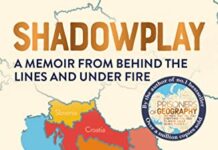
Ebook Info
- Published: 2016
- Number of pages: 320 pages
- Format: PDF
- File Size: 11.14 MB
- Authors: Tim Marshall
Description
In this New York Times bestseller, an award-winning journalist uses ten maps of crucial regions to explain the geo-political strategies of the world powers—“fans of geography, history, and politics (and maps) will be enthralled” (Fort Worth Star-Telegram).Maps have a mysterious hold over us. Whether ancient, crumbling parchments or generated by Google, maps tell us things we want to know, not only about our current location or where we are going but about the world in general. And yet, when it comes to geo-politics, much of what we are told is generated by analysts and other experts who have neglected to refer to a map of the place in question. All leaders of nations are constrained by geography. In “one of the best books about geopolitics” (The Evening Standard), now updated to include 2016 geopolitical developments, journalist Tim Marshall examines Russia, China, the US, Latin America, the Middle East, Africa, Europe, Japan, Korea, and Greenland and the Arctic—their weather, seas, mountains, rivers, deserts, and borders—to provide a context often missing from our political reportage: how the physical characteristics of these countries affect their strengths and vulnerabilities and the decisions made by their leaders. Offering “a fresh way of looking at maps” (The New York Times Book Review), Marshall explains the complex geo-political strategies that shape the globe. Why is Putin so obsessed with Crimea? Why was the US destined to become a global superpower? Why does China’s power base continue to expand? Why is Tibet destined to lose its autonomy? Why will Europe never be united? The answers are geographical. “In an ever more complex, chaotic, and interlinked world, Prisoners of Geography is a concise and useful primer on geopolitics” (Newsweek) and a critical guide to one of the major determining factors in world affairs.
User’s Reviews
Editorial Reviews: Review “Quite simply, one of the best books about geopolitics you could imagine: reading it is like having a light shone on your understanding.” ― The Evening Standard”In an ever more complex,chaotic and interlinked world, Prisoners of Geography is a concise and useful primer on geo-politics.” ― Newsweek Europe”Marshall is excellent on some of the highways and byways of geopolitics.” ― Financial Times“This is not a book about environmental determinism – the geography of aregion is never presented as fatalistic; but it does send a timely reminderthat despite technological advances, geography is always there, often forcingthe hand of world leaders.” ― Geographical Magazine”Fans of geography, history and politics (and maps) will be enthralled.” ― Fort Worth Star-Telegram”Lively and perceptive political and historical analyses are frequent. The chapter on China is excellent; the chapter on Africa combines geography and history in a convincing way; the chapter on Western Europe…is a brilliant narrative of European relations,particularly between France and Germany. The superb chapter on the Middle East makes for a clear indictment of the Sykes–Picot agreements and of their tracing of artificial borders. The chapter on the Arctic is precise and informative …A very lively, sensible and informative series of country reports in which geography occupies its rightful place along with shrewd historical reminders and political judgments.” ― Survival: Global Politics and Strategy”Marshall’s insistence on seeing the world through the lens of geography compels a fresh way of looking at maps—not just as objects for orientation or works of art, but as guideposts to the often thorny relations between nations.” ― New York Times Book Review”This book is especially timely…Landscapes, rugged or otherwise, and what the land holds in resources, exert their own kind of sway that no one, not even a Putin, can surmount. This book grabbed me because of its enormous relevance to our world today.” ― Booktrib.com“A convincing analysis of Russian geopoliticalthinking….Also makes clear the terrible price the world has had to paybecause European officials decided to create nation-states with borders thatcompletely ignored cultural geography.” ― Washington Post About the Author Tim Marshall is a leading authority on foreign affairs with more than thirty years of reporting experience. He was diplomatic editor at Sky News and before that worked for the BBC and LBC/IRN radio. He has reported from forty countries and covered conflicts in Croatia, Bosnia, Macedonia, Kosovo, Afghanistan, Iraq, Lebanon, Syria, and Israel. He is the author of Prisoners of Geography: Ten Maps That Explain Everything About the World; The Age of Walls: How Barriers Between Nations Are Changing Our World; and A Flag Worth Dying For: The Power and Politics of National Symbols. He is founder and editor of the current affairs site TheWhatandtheWhy.com.
Reviews from Amazon users which were colected at the time this book was published on the website:
⭐I wish I had found this book BEFORE I read “Guns, Germs, & Steel” because then I may have found that longer, denser, more scientific book more palatable. Tim Marshall has done a marvelous job of distilling the major regions of the world into concise, entertaining, and educational sections. I lost track of all my highlights!Part of why I gave this book five stars was for the entertainment side. I’m well-traveled and decently well dedicated and know that the US is not kindly regarded everywhere by everyone. We still have the power to back up our ego…for now.I visited China for study abroad in 2017 and first learned of the One Road, One Belt policy then. It’s both shocking and unsurprising how far they’ve come in less than a decade.Of course, reading this in June 2022 makes me sad and frustrated about how much further Russia DID go regarding Ukraine. They didn’t stop at Crimea and now we’re all waiting to see how much further war will spread.
⭐Amazing study of global history and the ways that geography has defined the limitations and objectives of nations’ objectives. Incredible research summarized for each region of the earth.
⭐I thought this book did a great of explaining the answers to questions that I have had for awhile. It made a lot of sense, and I enjoyed the explanations. The book was well-written. As the author says, geography does not determine your fate but it does influence it. I liked the book so much that I am now reading the follow-up book “The Power of Geography”.
⭐The author starts with flawed and erroneous premises and then proceeds to ignore contradictory facts. He starts right away on page 7 by stating that the USA with its long range bombers has no need for military bases overseas, completely ignoring that the US military is maintaining more than 1100 bases in more than 135 countries around the globe. He refers to Mark Sykes drawing the boundaries for the post WW I Middle East in 1916 but these lines had been in discussion since at least 1906. To admit this would be to implicate the British as empire builders with a venal purpose in entering into the war. He talks about the Israeli’s needing the West Bank as a buffer which is ludicrous in an age of mechanized warfare (as witnesses by the French in June of 1940), but the Palestinians have occupied arable land for food production and a good water supply, both of which have been taken over by the invading Israeli’s.The author states: “The Americans are keen to scale down their political and military investment in the region due to a reduction in their energy-import requirements…” and so he completely ignores a key impetus for both the invasions of Afghanistan and Iraq and the building of permanent military bases in both countries, and also the US government’s instigation of the war in Yugoslovia to create an independent nation of Kosovo where the US quickly build a new airbase. A new airbase to project American power over the Caspian Basin, the second largest oil resource in the world, as well as providing a more direct routing for CIA drug trafficking of Afghanistan’s opium and heroin (no surprise that there was a 20-fold increase in production after the US led invasion).With regard to the partitioning of India by the British following World War II the author states “By 1947, the forces of postcolonial nationalism and religious separatism broke the subcontinent into two, and later three major pieces: India, Pakistan, and Bangladesh.” The British and their allies forced the partition to keep India from becoming the dominant player in the region. It is similar to how the western governments have played Iran against Iraq and vice versa.Instability makes it far easier for the bankers and the industrialists to plunder a country and its people. It is why the US has been actively involved in the overthrow of democratically elected governments in Iraq, Iran, Pakistan, and Egypt in this region, not to mention the overthrow of governments in Haiti, Guatemala, Panama, El Salvador, Nicaragua, Bolivia, Peru, Argentina, and Brazil.He even comments on the lack of sources of coal and oil for Japan and how they invaded China and the Philippines but then contradicts himself by saying that geography played a role in Hiroshima and Nagasaki. He restates the myth that the Japanese leaders wanted to continue the war at the time the men, women, and children living in these two cities were annihilated, when it is well known that the Japanese had been pushing for a peaceful settlement for months. How would the author explain the similar destruction of Dresden in February of 1945. Both situations entailed a large element of revenge. The atomic bomb demonstration was most likely done to intimidate the Russians and the Chinese which were considered incorrectly to be a distinct to the USA.Even more ludicrous for a “geographer” is how the author states that the lack of development in Latin America is the result of their major cities all being along the coast. How then to explain the United States where its major cities are along the coast of the Atlantic, Pacific, and Great Lakes. What is different with Latin America (and this applies to Haiti as well), is that the colonial powers that seized the lands and then distributed them to favorites as large slave plantations, had no interest in the development of independent workers and a middle class or in an industrial economy. To this day there are eight families that control Honduras and so the majority of the people live much as they did when the Spanish first invaded 400 years ago. The Honduran elites have monopolized what little commerce does exist with one family controlling all the beer production, another the concrete production, and so forth. Unfortunately for the people, capitalist elites love a fascist government to preserve the status quo.The author makes some incredibly ignorant postulations that the cocaine trade in Latin America is a function of geography when the reality is that the CIA has long supported cocaine production in the region and facilitated the flow of drugs in the US and this too is well documented. Under President Nixon the banking regulations were changed to allow more drug money to flow into Caribbean banks in the form of US dollars, and so propping up the currency during the deficit spending years of the Vietnam War. The author goes on to state that in Afghanistan the farmers growing opium were “either taking up arms or supporting the Taliban.” The Taliban banned opium and was directly responsible for the 95% decrease in production from the country. It was only after the USA/CIA led invasion that opium production returned to pre-Taliban levels. From the NY Times May 20, 2001 article: “The first American narcotics experts to go to Afghanistan under Taliban rule have concluded that the movement’s ban on opium-poppy cultivation appears to have wiped out the world’s largest crop in less than a year, officials said today.”. The author also states that the Taliban led the fight against Soviet invaders when in point of fact the Soviets supported the government of Afghanistan and their assistance was requested by the government to counter the foreign fighters, trained by the US CIA and funded by the Saudi Arabian government, coming into the country to wage war.In his comments on Brazil he states that “When one in four of a state’s population is in abject poverty it is difficult for that state to become rich.”Evidently Tim is not aware that in the United States when President Lyndon Johnson declared his war on poverty (a Democrat’s kind of war)one quarter of the people living in the country were in abject poverty. And with the freezing of income for workers at pre-1980 levels for the past 40 years the situation is only more stark with the uber rich and the those living in extreme poverty.I usually pass along books I have read but this one is destined for the recycle bin and hopefully the paper will go into something of value.
⭐I like the perspective this book offers, namely viewing world affairs as driven by and constrained by national and regional geography. Author Tim Marshall divides our planet into ten large areas whose external boundaries and internal divisions shape the behavior of those who live within them, in particular, that of leaders and governments.Ten maps preface each of the ten chapters while providing a frequent go-to reference for readers as Marshall explores how landforms, rivers, plains, and ports have affected the politics and conflicts in each region. I did not detect any wasted space or filler material in this book; in fact, it is jammed with useful insights and “ahas” about the world today. I do not have anything to offer in the way of shortcomings: it’s just a conceived book on a topic that gets little attention.Why does Russia want Ukraine? What motivates China to build a major port facility on the Indian Ocean in Pakistan? How does geography help to explain the contrast between European and African economic development? Which countries are preparing for conflict in the Arctic as sea ice retreats further year after year? The beauty of this book lies in placing a global basket of territorial imperatives side by side, map by map so that the reader gets a holistic view of geopolitics.The book raised my awareness about the role of geography in the politics of conflict. Argentina still wants the Malvinas (Falkland Islands), climate change drives a serious Nile River water-rights dispute between Ethiopia and Egypt, and several international conflicts simmer in the Arctic region. More than a score of geographically-driven political hot spots exist around the world, all neatly presented in this book in their geographical context.Prisoners of Geography is a must-read if you follow geopolitics. If you do not, you may find yourself both fascinated and better informed after reading it.
⭐I am not a geography expert and will admit, I read this book with a globe at the ready.I greatly enjoyed Mr Marshall’s work!!
⭐If your geography could use some work, this book is a great kick start. My kids actually listen when I point at a map and talk now. Yes, that really is where Moscow is!
⭐Really insightful and an easy read. While the maps included in the book are good, plan to pull up google earth for further detail.
⭐Brilliant essay by Tim Marshall. After reading this book, you’ll be really convinced that we’re “prisoners of geography”. The illustration of the effect that geography has in determining geopolitics is striking and compelling. Understanding the geopolitics of Russia, China, Europe, North America, Middle East, India and East Asia becomes much easier if these regions are observed through the lenses of geographical constraints (or lack thereof) as well as history.The only defect of this book is that you just can’t have enough. Huge regions like Africa or South America just get a single chapter each, and there’s no Oceania/Australasia or South East Asia.
⭐Brilliant book made even better with more maps.
⭐Written in a way that is easily understood. Simple vocabulary.No side taken. Left me wondering why I had never thought of geography playing such a major role in a nations history and thinking.
⭐The media concentrate on the ephemeral – “news” – so it is helpful to be reminded of how decisively and permanently geography shapes international relations. There are, however, signs of haste, including errors of fact and some doubtful assertions. Examples: Ivan III, the Great, was the first Russian ruler to use the title “Tsar”, not his descendant Ivan IV, the Terrible. Lake Nicaragua is not the largest freshwater lake in Latin America; Lake Titicaca is seven times larger. The Sykes-Picot agreement had little to say about the Arabian Peninsula, as opposed to the settled lands north of it. If the Korean Navy could not reach the Sea of Japan and the East China Sea, it would be permanently confined to port. I doubt whether the Mississippi is a larger waterway network than the Amazon: it certainly cannot carry ocean-going ships.On a wider scale the author emphasizes how geography has given the USA immunity from land-based invasion. This is true, but it is something of a poisoned chalice. Geography also encourages the USA in its exceptionalism, which in turn makes it increasingly out of step with the 96% of humanity who are not Americans. It is significant that it is now the only country out of 193 that has not adopted the metric system. As the Irish widow said, they’re all out of step except my boy Pat.
⭐Very good
Keywords
Free Download Prisoners of Geography: Ten Maps That Explain Everything About the World (Politics of Place) in PDF format
Prisoners of Geography: Ten Maps That Explain Everything About the World (Politics of Place) PDF Free Download
Download Prisoners of Geography: Ten Maps That Explain Everything About the World (Politics of Place) 2016 PDF Free
Prisoners of Geography: Ten Maps That Explain Everything About the World (Politics of Place) 2016 PDF Free Download
Download Prisoners of Geography: Ten Maps That Explain Everything About the World (Politics of Place) PDF
Free Download Ebook Prisoners of Geography: Ten Maps That Explain Everything About the World (Politics of Place)



